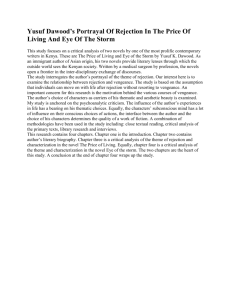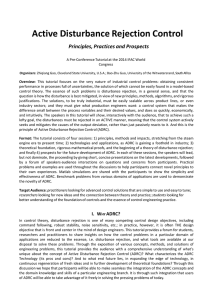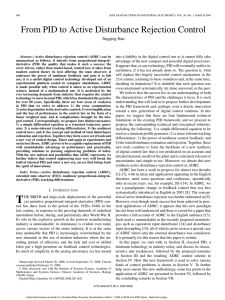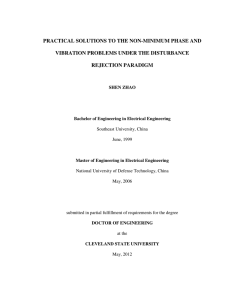Cleveland State University Department of Electrical Engineering and Computer Science
advertisement
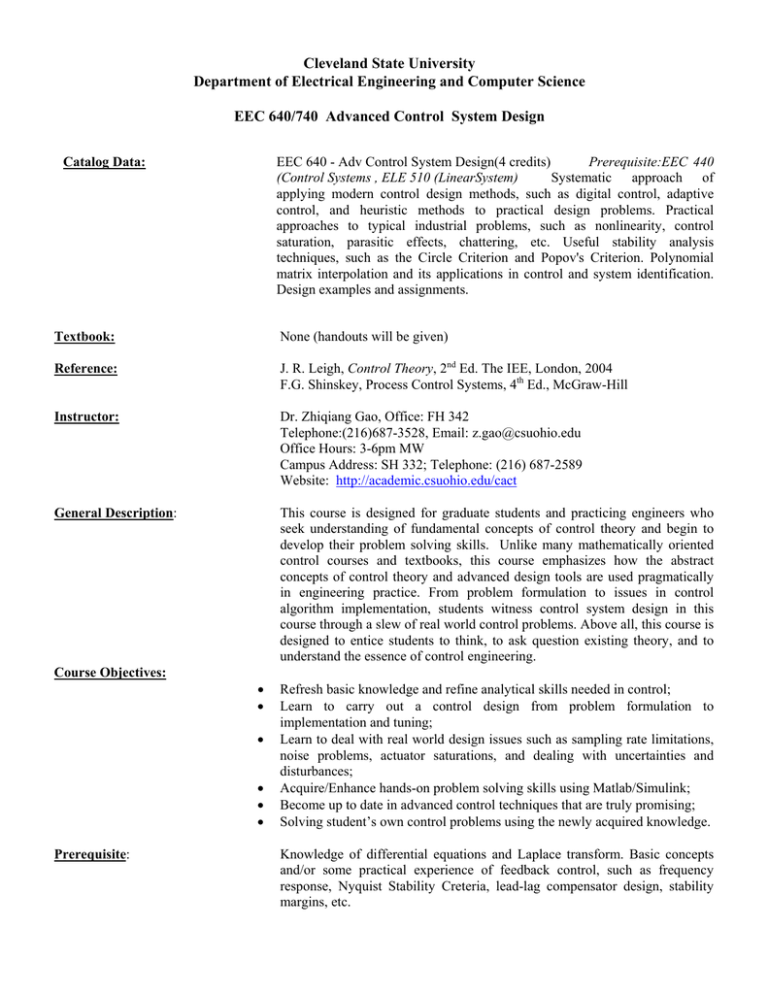
Cleveland State University Department of Electrical Engineering and Computer Science EEC 640/740 Advanced Control System Design Catalog Data: EEC 640 - Adv Control System Design(4 credits) Prerequisite:EEC 440 (Control Systems , ELE 510 (LinearSystem) Systematic approach of applying modern control design methods, such as digital control, adaptive control, and heuristic methods to practical design problems. Practical approaches to typical industrial problems, such as nonlinearity, control saturation, parasitic effects, chattering, etc. Useful stability analysis techniques, such as the Circle Criterion and Popov's Criterion. Polynomial matrix interpolation and its applications in control and system identification. Design examples and assignments. Textbook: None (handouts will be given) Reference: J. R. Leigh, Control Theory, 2nd Ed. The IEE, London, 2004 F.G. Shinskey, Process Control Systems, 4th Ed., McGraw-Hill Instructor: Dr. Zhiqiang Gao, Office: FH 342 Telephone:(216)687-3528, Email: z.gao@csuohio.edu Office Hours: 3-6pm MW Campus Address: SH 332; Telephone: (216) 687-2589 Website: http://academic.csuohio.edu/cact General Description: This course is designed for graduate students and practicing engineers who seek understanding of fundamental concepts of control theory and begin to develop their problem solving skills. Unlike many mathematically oriented control courses and textbooks, this course emphasizes how the abstract concepts of control theory and advanced design tools are used pragmatically in engineering practice. From problem formulation to issues in control algorithm implementation, students witness control system design in this course through a slew of real world control problems. Above all, this course is designed to entice students to think, to ask question existing theory, and to understand the essence of control engineering. Course Objectives: Prerequisite: Refresh basic knowledge and refine analytical skills needed in control; Learn to carry out a control design from problem formulation to implementation and tuning; Learn to deal with real world design issues such as sampling rate limitations, noise problems, actuator saturations, and dealing with uncertainties and disturbances; Acquire/Enhance hands-on problem solving skills using Matlab/Simulink; Become up to date in advanced control techniques that are truly promising; Solving student’s own control problems using the newly acquired knowledge. Knowledge of differential equations and Laplace transform. Basic concepts and/or some practical experience of feedback control, such as frequency response, Nyquist Stability Creteria, lead-lag compensator design, stability margins, etc. Project and Term Paper: Each student is required to select a real world control problem and use it throughout the course as a case study. New design techniques are evaluated against existing ones by each person in his/her own case study. At the end of the course, a term paper is required summarize the investigations. The goal through out the semester is to make this paper such a high quality that it is publishable with little or no modifications. Technical Writing: Writing assignments will be given regularly. Project reports and term papers are required to be written in a manner that satisfies IEEE Guideline. Help can be found at the above website. Presentation: All students are required to make a term paper presentation at the end of semester. Doctoral students are required to make two additional presentations (problem formulation and progress report). Grade Determination: Class Participations Design Projects Term Paper and presentation Test 20% 30% 30% 20% Topics What concepts and where did they come from? -- a review of basics What do we want? -- performance evaluation of in control practice What makes it so interesting? -- bridging the theory-practice gap: problem solving strategy and process in the real world How much do we need to know about a physical process in order to design a controller for it? – the premise of modern control theory and its consequences Robust control: how much uncertainty can a control system tolerate? Industry control: how much uncertainties are out there? Why feedback control? – how we strive for consistent performance in a system made of inconsistent parts? Why not feedback control? – the inherent limitation of feedback: stability and latency Why feedforward? – the advantage of anticipation Active vs. passive disturbance rejection: the new vs. old design paradigm Estimating and mitigating uncertainties The rejection of total disturbance, including internal dynamics and external forces ADRC (Active Disturbance Rejection Control): concept, algorithm, and applications The future of control theory and practice beyond modern control Modules Module I Week 1-2: 1. Introduction to Advanced Control a. History b. Current practice c. Challenges 2. Paradigms of Control Design a. Academic b. Industry c. Disturbance Rejection 3. How to do research on control problems 4. Assignment 1: Find a theme problem: write a five page description, plus figures, on two real world control problems and their current solution. Prepare to use one of them as a theme problem throughout the semester to test new knowledge with. 5. Assignment 2: Start Thinking about an Interesting Research Problem Module II Week 3-4: 1. Basic Concepts a. Modeling b. Time Response c. Frequency Response 2. Classical Control Concepts a. Nyquist Stability Creteria b. Stability Margins 3. Putting the concepts to practice 4. Midterm Test 1 5. Assignment: Research Problem Presentation Module III Week 5-6 1. Classical Design Tools a. PID b. Pole placement c. Loop shaping 2. Design Specfications 3. Applying the concepts and design tools to the theme problem 4. Assignment: write a professional report documenting the results. Module IV Week 7 1. Review and Midterm Test 2 Module V Week 8-9 1. Modern Control Concepts and Tools a. State Space and Kalman Filter, a history b. Controllability and Observability c. State Feedback d. State Observer 2. Design Specfications 3. Applying the concepts and design tools to the theme problem 4. Assignment: write a professional report documenting the results of Part b. 5. Term paper progress report due Module VI Week 10-11 1. Active Disturbance Rejection Control a. From Poncelet to CACT, a short history b. Extended State Observer c. ADRC concepts and design tool d. Implementation 2. Design Specfications 3. Applying the concepts and design tools to the theme problem 4. Assignment: write a professional report documenting the results. Module VII Week 12 1. Analysis of Active Disturbance Rejection Control a. Transfer Function Representation b. Stability Margins and Robustness c. Stability Proofs d. Implementation 2. Assignment: write a report documenting the analysis of the ADRC solution. Module VII Week 13 1. Discrete Time Optimal Control and its Applications a. Discrete TOP formulation b. Solution c. Implementation d. Test 2. Apply DTOC to the theme problem and write a report 3. Submit the complete report of the theme problem solutions. Module VIII Week 14-15 Term Paper Presentations by Students Submit the Term Paper



